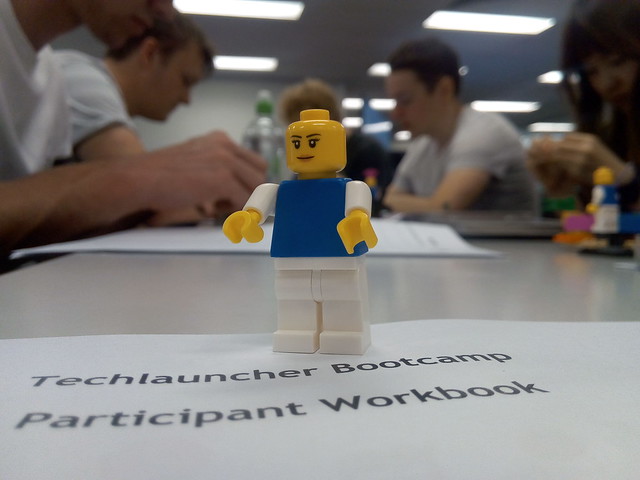Description: Tom teaches university computing students how to undertake real projects for real clients. This has included an artifact mapping tool for the Plain of Jars in Laos and test software for the radars on Australian warships. These real-world projects require real-world assessment techniques, including e-portfolios. In this presentation he discusses:
- Innovative education techniques to teach students how to better communicate with employers and people
- How to build students confidence and capture their skills set to become more job ready
- How to provide formal postgraduate education to students in their workplaces via mobile devices
About the Speaker: Tom Worthington is an independent computer professional, educational designer and an Honorary Senior Lecturer in the Research School of Computer Science at the Australian National University.
A Certified Professional member of the Australian Computer Society, in 2015 Tom received a national gold Digital Disruptors Award for "ICT Education" and in 2010 was Canberra ICT Educator of the Year. Tom previously worked on IT policy for the Australian Government, and in 1999 he was elected a Fellow of the Australian Computer Society for his contribution to the development of public Internet policy. He is a Past President, Honorary Life Member, Certified Professional and a Certified Computer Professional of the society as well as a voting member of the Association for Computing Machinery and a member of the Institute of Electrical and Electronics Engineers.
Tom has a Masters in Education (specializing in Distance Education) from Athabasca University, a Graduate Certificate in Higher Education from the Australian National University and a Certificate IV in Training and Assessment from the Canberra Institute of Technology. He blogs as the HigherEducationWhisperer.com. He blogs as the HigherEducationWhisperer.com.
These are the notes for the presentation using HTML Slidy. If viewing the slides you can press "A" to display these notes (and press "A" again to hide them). To advance to the next slide, press "page down", or click the left mouse button.
Dogfooding is a term coined by Harrison (2006), for the practice of using the product you are advocating. Teachers need to learn new teaching and assessment techniques by being students themselves, experiencing those techniques.
I was trained in computing within the Australian Public Service (APS), through what is now known as Work Integrated Learning (WIL). Starting as a Programmer's Assistant in the Australian Bureau of Statistics, I undertook clerical tasks to assist the programmers, while being trained in computing, in small in-house classes with teachers contracted from the computer industry. This format continued through my almost two decades with the APS.
Leaving the APS, I became a freelance computer consultant and part-time higher education teacher. Continuing the Dogfooding approach, my education about education was conducted mostly online and using work-integrated-learning, with the tools I intended to use for teaching.
My online studies were mostly of a conventional nature, with course design which would have been familiar to the last century distance education designer. Courses relied on textbooks (paper or electronic), downloaded text-rich notes and readings from academic books and journals. Courses were administered using a Learning Management System (LMS). ANU, USQ, CIT and Athabasca University all use the Moodle LMS. Students had limited interaction by asynchronous Moodle based chat forums. Most assignments were individual, with some group-work and most material was submitted as a word-processing document. Exceptions were courses on mobile learning and learning technology, which used a range of tools and techniques.
The most significant and different learning experience was the last: the Athabasca University MEd capstone portfolio. The Capstone e-portfolio requires the students to reflect on their learning using five artifacts, which usually are a subset of the assignments already submitted in coursework (Hoven, 2015, p. 23). Rather than just leave the student to work this out for themselves, the e-portfolio is structured as a twelve-week course in the student's last term (I took this concurrently with my last course). There was an instructor, and the student completes the e-portfolio in sections. Students receive feedback from the instructor and provide comment on each others draft e-portfolios. The last task is for the student to present an hour-long defense of their e-portfolio: thirty minutes presentation and thirty minutes answering questions from staff and students, via a webinar.
A copy of my Capstone e-portfolio is available. An extended version is available as a book: Digital Teaching In Higher Education: Designing E-learning for International Students of Technology, Innovation and the Environment.
Provide: eBooks, discussion forums, tools for inquiry and assessment.
Pictographs by Carlos Sarmento from the Noun Project (CC BY 3.0 US).
The cover of my book "Digital Teaching" is illustrated with the four pictographs by Carlos Sarmento (from the Noun Project CC BY 3.0 US). This summarizes an approach to education with four steps:
- Provide eBooks and other curated content on the topic;
- Facilitate discussion between the students;
- Teach tools and techniques for the student to explore the topic; and
- Assess, including formative feedback, to help them learn.
An e-portfolio tends to only be though of as part of the last step: assessment. But it can also can be used earlier with the student exploring the topic and discussing with others. Students can provide feedback on each others' drafts, before obtaining feedback from an instructor.
Five years of online study made me appreciate the value of classroom teaching. The typical university student will still want to meet face to face with other students and an instructor. However, this time should not be wasted on lectures, or tutorials, where the student sits passively.
ANU found that after the first two weeks only 30% of students attend a typical lecture. In a semester, that works out to less than 50% attendance.
ANU is demolishing the central Manning Clark Centre lecture theaters in late 2017, to be replaced by "a number of multi-purpose, multimodal, flexible learning spaces which will be embedded with new digital infrastructure".
No preferred learning approach has been set centrally by ANU. However, I suggest replacing lectures with a flipped classroom, will provide a better learning experience while halving the teaching space required. A typical "on-campus" student can be expected to be in "class" for no more than 10% of their study time. For a full-time student studying 40 hours a week, this would be 4 hours. A full-time student might spend as little as one day per week on campus, a part-time student, one day a month.
online students are more focused on each course and each assessment task. This is partly due to their being physically remote from the university. The student does not perceive the "university" as more than an administrative entity. Also, online students are more likely to be older, part-time and undertaking studies for work purposes. As a result, these students are focused on completing the assessment. The result is isolated, unhappy students.
The solution is activities to introduce the students to the online services the university provides and getting the students to help each other. These have to be compulsory, formal, assessed, for-credit activities. It is not enough to have optional extra-curricular activities, as the task-driven online student will not do these. It is also not enough to have one introductory activity, as the student will revert to their previous isolated behavior.
Educational designers who know how to produce such activities for students. The challenge is to convince discipline specific academics to make room in degree programs for these "soft skills".
While the problem with engagement has been seen with distance education students, the use of blended learning on-campus will see the increase in the same problem. The same techniques can be used to help engage these students.
With this approach, the soft-skill activities wrap around the classroom time, much as the new glass and steel of the Irving K Barber Learning Centre, wraps around an old stone building at the University of British Colombia.
Version 0.1, 15 May 2018, Tom Worthington.

Using an ePortfolio to capture
students' skill sets to align to workplace by Tom Worthington is licensed under a Creative Commons
Attribution-ShareAlike 3.0 Unported License.














